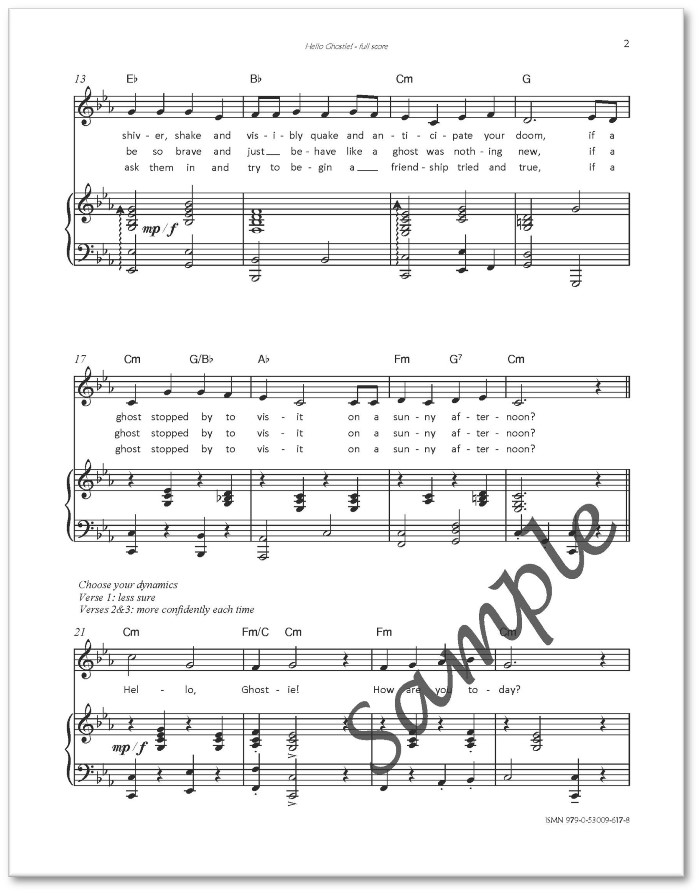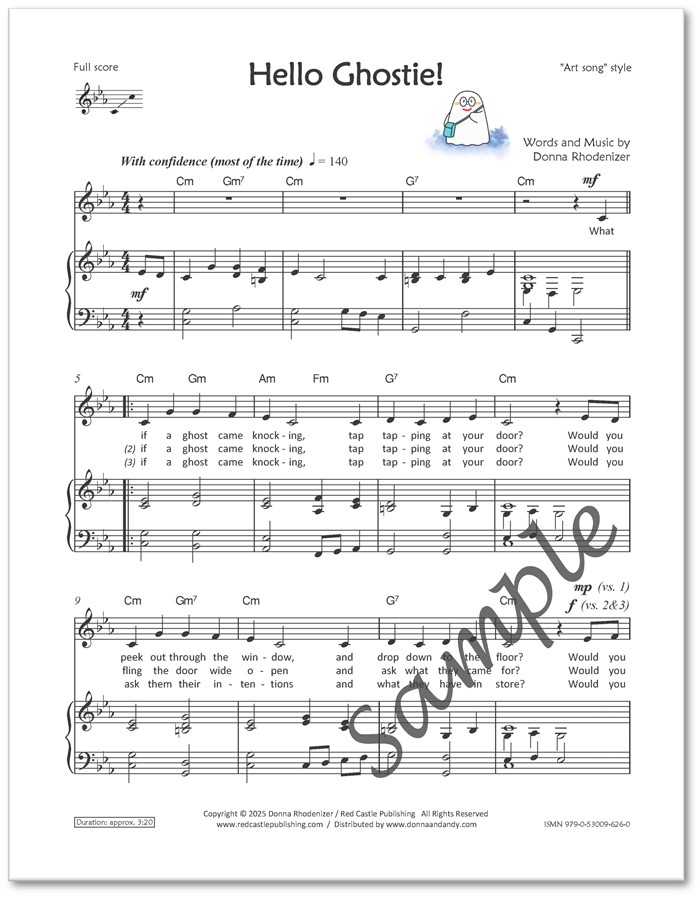Hello Ghostie!
Price range: $11.00 through $50.00
What would you do if you heard a knock at the door and when you opened the door you discovered a ghost standing there? Singers have the opportunity to delve deep into their expressive singing skills to present a variety of emotions. Are they afraid? Are they confident? Are they brave? Do they cycle through all of these emotions?
Hello Ghostie is written in a minor key with a one-octave range (C4-C5) sitting well within the vocal range of young singers. The song is written in a “sea shanty” style with strong accented, chordal accompaniment. Expressive singing is an important feature of this song requiring attention to dynamics that need to change with the changing emotions of the singer as the story unfolds.
A second accompaniment option is provided, written in a style that is more in the art song genre. Singers may use either accompaniment for performances or explore both versions as a score study to discuss how accompaniment style changes the vocal presentation and feel of the song.
Listen to melody + accompaniment:
Listen to melody + accompaniment (art song style)
Download Includes:
- Vocal score
- Lead sheet
- Director/piano score – Sea shanty style
- Director/piano score – Art song style
- Lyrics
- Accompaniment – with melody guide (both styles)
- Accompaniment – piano (both styles)
- Teaching Tips
- Singer’s Notes
Share this page using these social links!
Hello Ghostie!
Follow along with the lyrics as you listen to the accompaniment with melody guide for Hello Ghostie!.
Art Song style

Teaching Tips
Style study
Hello Ghostie! is written with two different accompaniment styles.
Sea Shanty style
The song has a jaunty, rollicking feel with heavy chordal accompaniment.
How will the story be presented in this style?
Art Song Style
Hello Ghostie! is also provided with an accompaniment written in an art song style.
How will the song be sung differently within this style?
Singers should sing expressively in both accompaniment styles.
Expressive singing
Dramatic interpretation and expressive singing can be incorporated in the responses to the ghost at the door.
Sing “Hello Ghostie” different ways:
- bravely
- anxiously
- curiously
When singing repeated lyrics “Hello Ghostie. How are you today?” each chorus can be sung with the same emotional response, or singers may choose to sing each response with a different emotion each time.
See the “Singer’s Notes” included with the PDF download. The composer, Donna Rhodenizer, has written instructions to the singers who will be interpreting the song.
Add percussion
The purpose of a sea shanty was to have a song that could be sung while doing tasks such as pulling rigging ropes when sailors would need to work together. Singing songs with a strong and steady beat provided the reference for all the sailors to pull at the same time, therefore being most efficient and productive.
Add percussion to Hello Ghostie! The PDF download includes specific percussion suggestions to try. Singers also are invited to create a percussion part to include in the performance.
Hello Ghostie!
Halloween songs can be a great teaching tool. They often include minor tonalities, lots of “oohs” and other sound effects, and topics that are mysterious and fun to sing. These songs tie in with the anticipation children experience leading up to Halloween festivities at the end of October. However, in my music classroom some students didn’t partake in any Halloween observances. Ghosts in particular are a sticky subject. Are they real? Are they just stories? Some kids believe strongly, other do not and others are not sure. Where does my responsibility lie when students look to me for opinions?
Hello Ghostie! was written as a way of giving young singers some tools for dealing with ghosts in general. Not to present ghosts as scary, horror-movie kind of creatures, but acting like regular people by walking up to a house and knocking on the door to have a visit. How would you react if you heard a knock at the door and when you opened it, a ghost was standing there? There are certainly a variety of possible reactions and I explored both afraid and brave responses for different verses. This makes for an interesting expressive singing exercise for singers. How will they sing a chorus with the same words but conveying different emotions? Will they sing each repetition of “Hello Ghostie” with changing emotions or keep it all the same within each chorus? I also composed the ending with room for interpretation. The singer must decide if they finish with brave confidence or maybe after all their bravado, a few doubts are still lingering and they aren’t quite sure of the outcome.
Composing the accompaniment for Hello Ghostie! was an interesting journey. Sea shanty songs are popular with young singers (and older ones too!) and this song fit that style very well. That is the style I wanted for my song. However, when I first framed out the accompaniment, I wrote out simple chords, basically to get the chord structure. This was a more sedate musical style and it also works well with the song. That meant I had to decide – but then again, maybe not! I decided to provide both accompaniment versions so singers can decide which accompaniment suits their needs. It also creates a neat learning experience to compare two styles of accompaniment that make a song sound different, even though the melody and words are exactly the same for both versions. I am always interested in encouraging musical exploration and creativity.
I like writing songs where the singer has the opportunity to make musical decisions about their performance – which should happen every time someone sings, but often does not. It is one of the most difficult things I do as a composer to commit myself to one specific interpretation of a song. There are so many options and there are reasons to include or omit different dynamics in a song. In the teaching tips for this song, I included specific notes written to the singer instructing them to make the song their own by adding the dynamics they think work best, even if that means ignoring what I wrote in the score. It will be interesting to experience a variety of performances of this song as it develops its own personality in the singing world.
When you have enjoyed singing this song with your students - please drop by again and leave a Review on this page. Thanks!
Send us your video of Hello Ghostie! and perhaps we can post it here.
| License | Vocal Solo / Single User License, Studio / School License, Small Ensemble License, Small Choir License, Large Choir License |
|---|---|
| Context | Choir – Elementary, Choir Repertoire, Classroom Songs, Expressive Storytelling Songs, Small Group Class, Vocal Solo, Choir – Unison |
| Topic | |
| Level | |
| Voicing | |
| Vocal Range | C4 – C5 |
| Duration | |
| Composer | Donna Rhodenizer |







Reviews
There are no reviews yet.